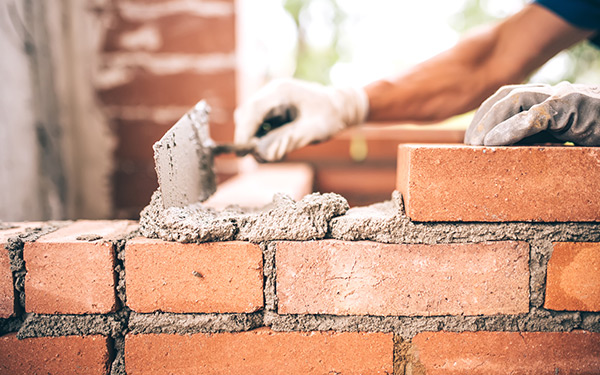Opening the Keys of Lasting Stonework Construction Practices for Eco-Friendly Structures
Among the myriad strategies to environment-friendly building, sustainable stonework building stands out as a time-tested and long lasting technique that holds a riches of untapped potential. From the selection of materials to ingenious construction methods, the secrets to accomplishing sustainability within stonework construction are diverse and interesting.
Benefits of Sustainable Masonry Construction
Embracing sustainable masonry construction techniques not just lowers ecological influence yet additionally offers lasting financial advantages to builders and communities. By utilizing materials like recycled blocks, obstructs, and stones, builders can significantly reduce the carbon impact of their tasks while advertising source performance. Additionally, sustainable masonry construction methods, such as correct insulation and thermal mass residential or commercial properties, can improve power effectiveness within buildings, causing decreased operational costs with time.
In addition, the toughness and durability of masonry frameworks contribute to long-term financial benefits. Buildings created making use of sustainable masonry methods typically need less repair and maintenance, equating to cost financial savings for building contractors and homeowner. The durability of masonry materials additionally guarantees that structures continue to be steady and safe and secure, lowering the demand for regular improvements or substitutes.
Eco-Friendly Stonework Products
Using environmentally friendly stonework materials is a critical step in the direction of enhancing the sustainability of building and construction methods and decreasing ecological influence while optimizing long-term economic advantages. Lasting masonry materials are sourced, generated, and used in a fashion that minimizes general environmental influence. Materials such as recycled bricks, redeemed stone, and lasting cinder block are ending up being significantly popular selections for eco-conscious home builders. Recycled bricks, for instance, not just divert waste from land fills but likewise need less energy to create compared to new bricks. Reclaimed rock offers a distinct aesthetic charm while minimizing the demand for brand-new quarrying. Lasting concrete obstructs include recycled accumulations and might include enhanced insulation residential properties, adding to power performance in structures.
Additionally, all-natural products like adobe, rammed earth, and straw bales provide excellent thermal mass properties, reducing the demand for home heating and cooling power. These products are typically locally readily available, advertising regional economic climates and decreasing transportation-related carbon emissions. By choosing environmentally friendly masonry materials, building and construction jobs can dramatically reduce their environmental impact and add to the creation of much healthier, a lot more sustainable built settings.
Energy-Efficient Stonework Methods
Energy concrete edging stamps effectiveness plays an essential function in improving the sustainability of stonework building methods. One vital energy-efficient stonework technique is the use of thermal mass, which involves integrating thick products like concrete or block right into the building's structure to soak up and store warm.

Developments in Lasting Stonework
Current innovations in lasting masonry techniques have actually produced innovative techniques that are reshaping the building and construction sector. One such technology is the growth of self-healing concrete, which makes use of germs embedded within the concrete to heal fractures autonomously. This advancement not only reduces maintenance prices yet also enhances the resilience of masonry structures, adding to their sustainability.
An additional notable innovation is using recycled accumulations in masonry construction - masonry contractor. By integrating materials such as smashed ceramic waste or recycled glass right into concrete mixes, building contractors can decrease the ecological effect of construction jobs while maintaining structural stability. This method not just draws away waste from landfills however also preserves all-natural sources, making it an essential innovation in sustainable masonry building
In addition, the assimilation of check my source digital design tools, such as Structure Info Modeling (BIM), is changing the way masonry structures are prepared and built. BIM permits even more precise computations, reduced material waste, and improved energy performance, inevitably leading to even more lasting structure practices. These advancements jointly indicate an appealing future for sustainable masonry building in the colored concrete walkways period of green structures.
Future Trends in Stonework Sustainability
With the innovative strides made in sustainable masonry techniques, the future patterns in masonry sustainability are poised to additional transform the construction sector. One of the key trends shaping the future of stonework sustainability is the enhanced integration of technology. Advancements such as Building Details Modeling (BIM) and digital truth simulations are being made use of to maximize masonry construction processes, bring about decreased product waste and enhanced energy performance in structures.
Moreover, the advancement of novel lasting products is readied to play a considerable duty in improving the eco-friendliness of stonework building. masonry contractor. Developments like self-healing concrete, recycled aggregates, and bio-based binders are obtaining grip for their ability to minimize ecological effect while preserving architectural integrity

Final Thought
Finally, sustainable stonework construction techniques offer various advantages for environmentally friendly structures. By making use of eco-friendly materials and energy-efficient strategies, stonework can contribute to an extra lasting built environment. Advancements in lasting stonework are continuously being developed to additionally boost the environmental performance of buildings. Looking towards the future, the fad of stonework sustainability is anticipated to grow, leading to even more ecologically pleasant and energy-efficient building and construction techniques in the years to find.